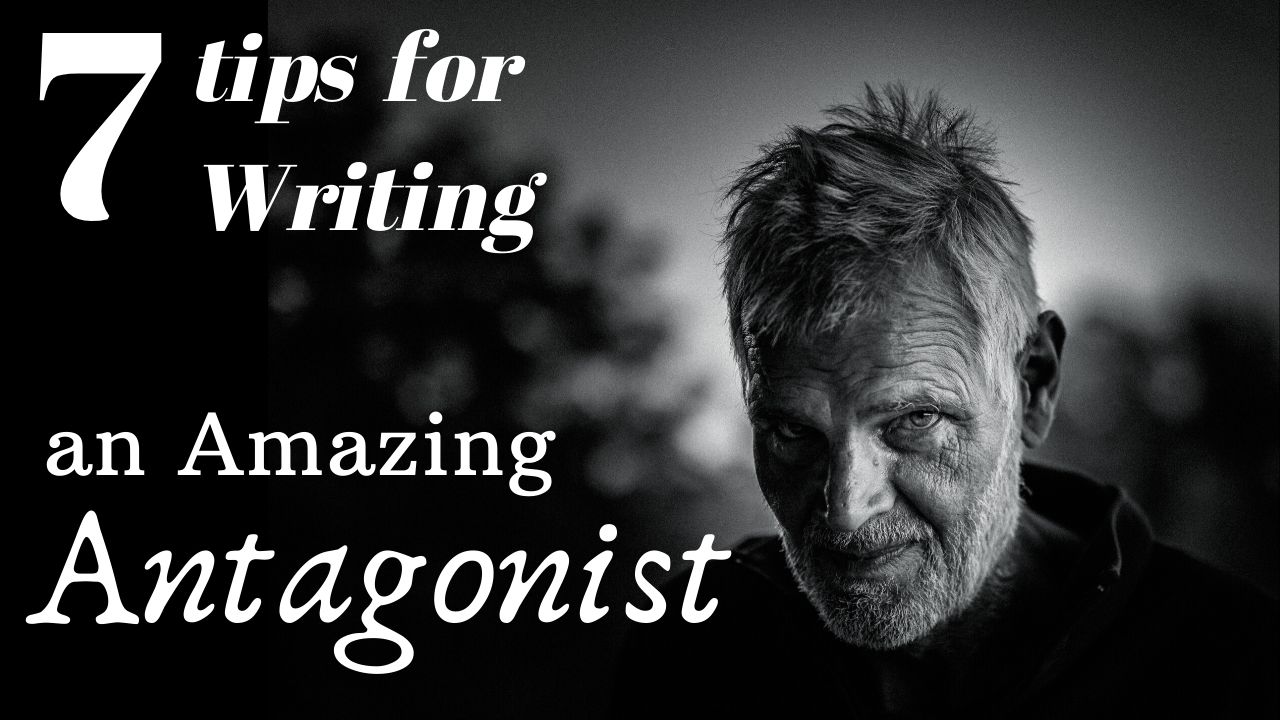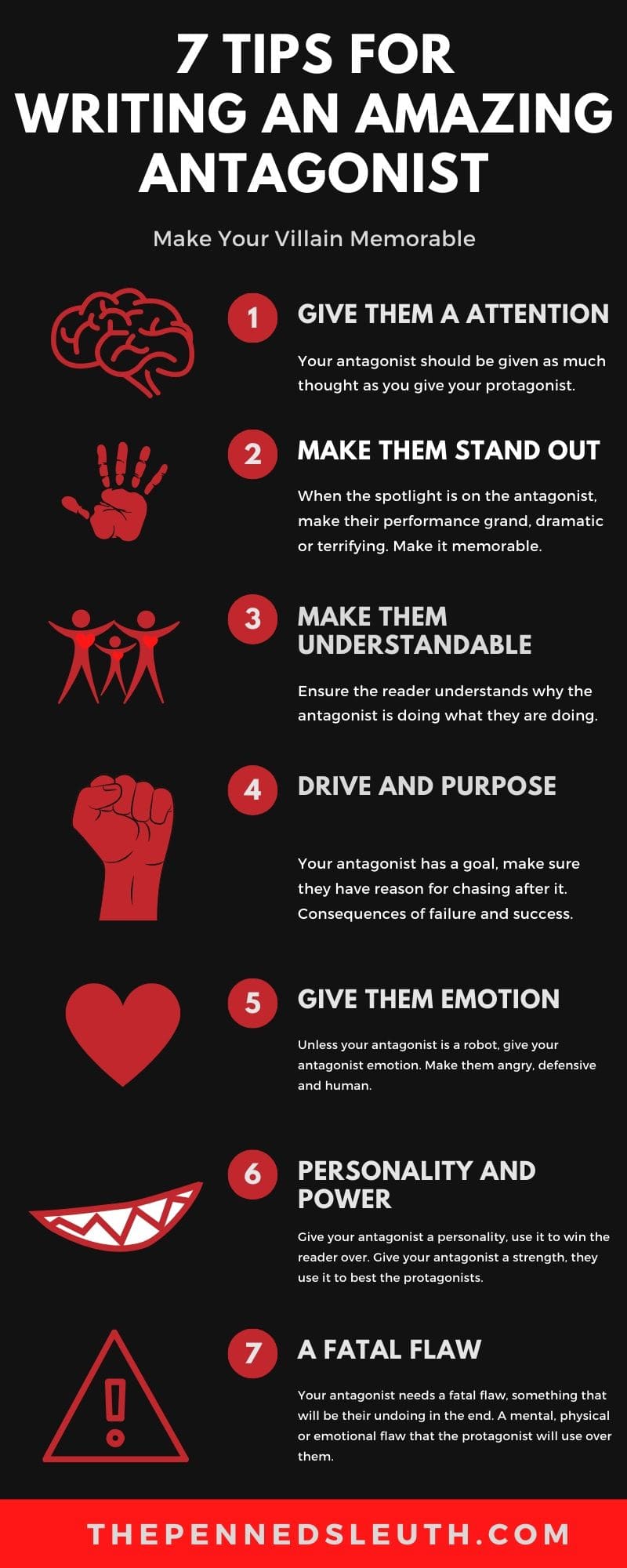Latest Writing Video! |
|
The antagonist, a character or characters that counter our protagonists, being an obstacle or an end goal. If the main character is the most important character, then the antagonist ties for that place. The importance of the antagonist cannot be understated, but we will talk more about that in a moment. Here are 7 Tips for Writing an Amazing Antagonist! Tip 1: The Level of AttentionThe level of attention you pay the antagonist is often overlooked. Most writers are more interested in their protagonist, developing them and creating many enjoyable scenes with them. It is fortunate that the reader often is as well, but that does not excuse the lack of attention given to the antagonist. Your villain needs to feel present in your novel. The reader needs to know why the protagonist is against them and why the antagonist is against the protagonist. There needs to be a clash of ideals, personalities. You spend a large amount of time rounding out your protagonist, but have you done the same for the villain? Lack of attention can lead to Side-Character Syndrome, a phrase I developed where an author puts little thought into a character, making the character seem like a side-character instead of the main character as intended. Your protagonist will come off forced and your antagonist as much of a mystery as they were in the beginning. You can solve this problem by putting the same amount of planning into the antagonist as you did the protagonist. Develop their personality, create their background story, give them strengths and flaws. The antagonist need not receive as much of the spotlight in your novel as the protagonist, but they need more thought behind them to come off as amazing. Tip 2: Make Their Moments MemorableSpeaking of the spotlight, when your antagonist has a scene to play their part, make it memorable. Use it effectively, to display the antagonist on a bright and shining podium. You can do this a many number of ways. It can be a scene where the antagonist demonstrates their power, where they fool the protagonist or where they disturb the reader with their evil. In these moments the reader needs to have the express desire to see the protagonist punch back, literally or figuratively. We can all recall amazing scenes in movies, such as the first conversation with Hannibal Lecter in Silence of the Lambs. Or the rebirth of Voldemort in Harry Potter. It won’t only be their introduction that terrifies the reader, but also their appearances and actions throughout the novel. It is in these moments the antagonist is most alive and present in your novel. With enough scenes, the character stands out and the reader can even enjoy reading their scenes as much as they enjoy the protagonist scenes. That is your goal for an amazing and memorable antagonist. Tip 3: Make Their Goal UnderstandableIt goes without saying that the antagonist needs a goal. Something they wish to attain through all their efforts. A goal that is understandable, if not reasonable, such as world domination. Such goals are extraordinary but understandable. The antagonist desires power in this case. Now, if your villain is not some super villain from a comic book, perhaps a smaller goal or desire would work better. The villain might wish to do harm to someone, just for kicks. Or, they might want to attain a fantastic measure of wealth without earning it and us now where that’s going. For whatever reason, their antagonist’s desire is immoral, illegal or both. Yet, not so far fetched that it’s unbelievable. If anything, the reader or protagonist needs to understand their goal, what pushed them to go after it. Yet, the goal must be unreasonable, a terrible reaction to whatever happened to the antagonist. Having that measure of relatability for the antagonist, even if it is only a small measure, is enough to add a mountain of depth and interest in the antagonist. Tip 4: Drive and PurposeWe have talked about the antagonist’s goal, but now we need to drive a purpose. We need to establish what is pushing them to reach the goal and what their purpose is in the novel as a whole. First, their drive. The antagonist has a goal, much like the protagonist, but they need a reason behind it. Something that pushes them to succeed, something to punish them if they fail. There needs to be stakes in addition to their desire. It only takes a moment to analyze the goal and the one working towards it to answer these questions. What made the antagonist desire such a goal? A wonderful question for building a bigger backstory. Perhaps also hinting at something deeper, more profound about the villain. Such development goes a long way. In addition to that point, the antagonist’s goal can be a noble one, but their actions in achieving such a goal are more than questionable. Such as world peace through the destruction of all life on earth. That is a means that definitely does not justify an end. Finally, keep their purpose in mind. The antagonist needs to conflict with the protagonist. For more basic antagonists this can be a simple argument between the two, or for more adventure novel antagonists, this can be the occasional physical combat. Whichever best suits your plan for your novel. Tip 5: The Emotions of the AntagonistIf your villain is a robot or a person who experienced an accident that leaves them no longer feeling emotion, you can ignore this tip. Yet, I’m sure for the majority of you, your villain is prone to the occasional outburst or heartfelt monologue outlining their evil desires. Most likely your antagonist is a human and with that in mind they will have humanly attachments. Your villain might have family, friends and loves ones. People the antagonist wants to protect, just like the protagonist. Your antagonist can go through bouts of grief, anger, and happiness. In this case, the villain might act accordingly. A disturbed one, in particular, might make hasty decisions which benefit the protagonist or take terrible steps to hurt the protagonist in some way, giving them more reason to stop the antagonist. You no doubt see where I am going with this point. You can use the emotions of the protagonist to not only add depth to the villain, make them more relatable, but also use these emotions to work with the plot. If you forget the antagonist has emotions and they simply follow the plot, they are no better than a robot. In which case, your antagonist will come off hollow and uninteresting, if they are not a robot anyway. Tip 6: Personality and PowerYour antagonist has two advantages in the story, one over the reader and the other over the protagonist. The first advantage is personality. The personality of the antagonist can be that of cruelty, like most typical villains. The villain can be a harsh person, bent on fulfilling their dark desires and crushing anyone in their way. Or, your villain can be more human, with a twisted side which makes them a villain. A sarcastic personality, an amusing personality and many more than making them unique. You can spend a lot of time picturing your many characters, giving them backgrounds and putting in all this effort for the villain as well, but if the antagonist lacks a personality fitting their actions and desires, it falls flat. Another vital feature of a villain you will need to go over, but wholly, a fun one. Some personalities amuse the reader, which is another plus. The second advantage, the antagonist’s strengths. It would be a miss not to give your antagonist any strengths. Something that gives them an edge over the protagonist, at least so far until their eventual fall. It could be an incredible intellect or physical strength. It could be their elusiveness, their ability to hide in plain sight. Anything that has them besting the protagonist and making steps towards their goal. Tip 7: The Antagonist Needs a Fatal FlawWe reach the final tip which is on the antagonist’s flaw. Everyone has their strengths, abilities or knowledge that help them. Yet, everyone has a crippling flaw that either holds them back or worse still, jeopardizes their plans. The flaw, of course, depends on the antagonist. Usually, it is the polar opposite of their strength. You could have an intelligent villain, but in a fight, they crumple like paper. It is this flaw that the protagonist uses to their advantage, that much is clear, but what isn’t clear is what flaw best suits your protagonist. What tips them over the edge? Does your antagonist fail to protect someone they care about? Does your protagonist get outsmarted thanks to their hubris? Does your finally get beaten at their strength, because the protagonist practiced more and the antagonist didn’t? The last thing your reader wants to read is your well-thought-out antagonist being bested through sheer luck. Find a flaw or create one and use it to create a brilliant show-down. ConclusionIf you keep all these tips and advice in mind, you will have no difficulty in creating and writing a brilliant antagonist. More so than that, you will have the opportunity to enjoy writing the antagonist. Writing is a fun experience and your enjoyment in writing such well-developed villains will only help improve the novel further. I hope you enjoyed this article and as always… Good day, goodnight and happy writing! Thank YouDear Writer, As a big thank you for reading this article I would like to offer you something for FREE! A writing course on how to improve your main character! Click here to check out your course. In addition, if you would like to receive more content, bonuses and some big discounts on future courses, join the writer’s group here. Thank you for reading! Kind regards Matthew Dewey, Writer Pin for Later!
1 Comment
peter
12/29/2023 09:33:20 pm
Explore the latest adult content at Pure Taboo. Watch the most interesting videos of attractive girls and boys ❤️🔥. <a href=" https://coupondonor.com/coupons/puretaboo ">Pure Taboo coupon code</a>
Reply
Leave a Reply. |








